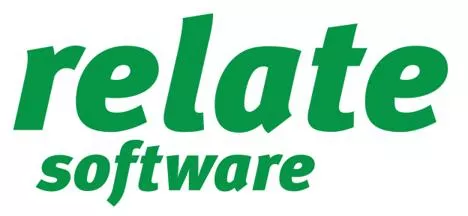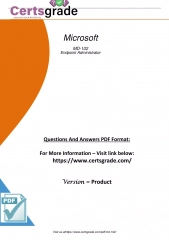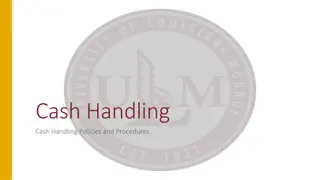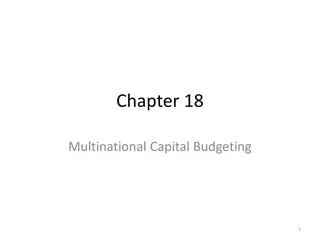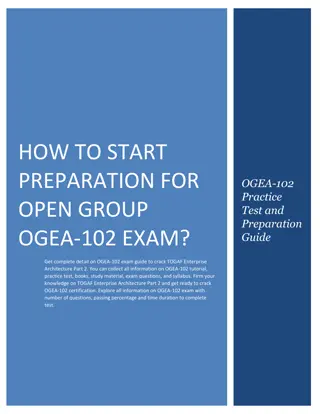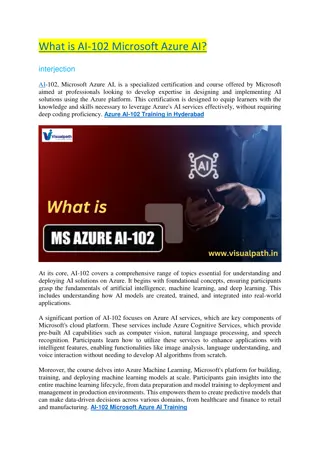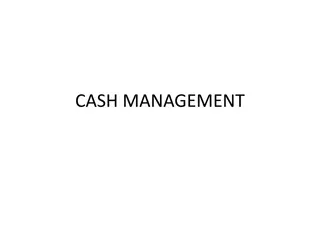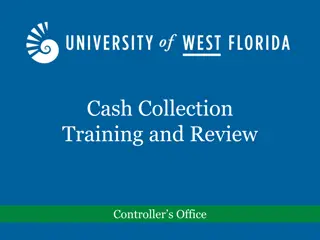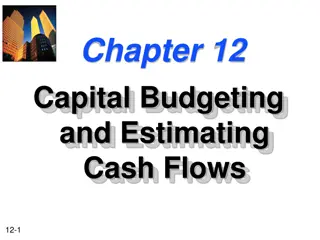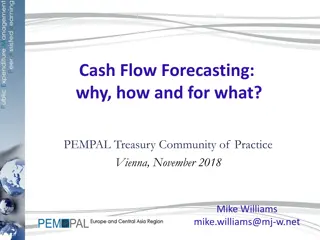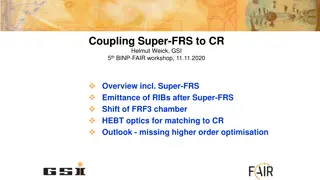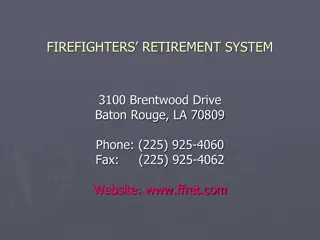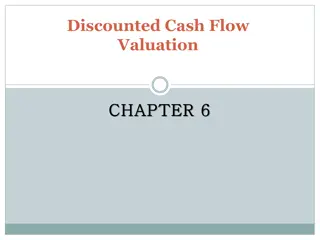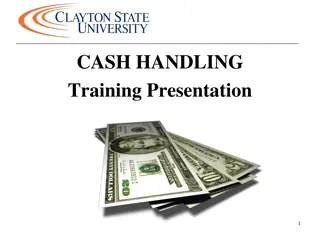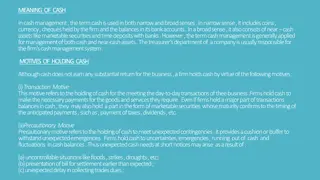Understanding Changes in Statement of Cash Flows under FRS 102
The Statement of Cash Flows has evolved under FRS 102, streamlining to three headings - Operating, Investing, Financing. Cash and Cash Equivalents are crucial components. Learn how to navigate challenges in preparing this statement and resolving discrepancies effectively.
Download Presentation

Please find below an Image/Link to download the presentation.
The content on the website is provided AS IS for your information and personal use only. It may not be sold, licensed, or shared on other websites without obtaining consent from the author. Download presentation by click this link. If you encounter any issues during the download, it is possible that the publisher has removed the file from their server.
E N D
Presentation Transcript
The Statement of Cash Flows has been introduced under FRS 102, which is somewhat different to the original Statement of Cash Flows under Old UK and Irish GAAP. There are now just three required headings instead of 9:- Operating Investing Financing The statement now reconciles to Cash and Cash Equivalents . Cash and Cash Equivalents are made up of the Total Cash and Bank Balance plus any cash equivalents (i.e. any deposits or investments that are seen as highly liquid or likely to turn into cash in a short timeframe). Relate Accounts Production is designed to accurately produce a Statement of Cash Flows from the postings the user creates, but sometimes some issues arise when postings are not quite correct.
The Statement of Cash Flows is automatically generated in accounts when the relevant postings are made. It will appear by default for Small, Medium and Large Companies incorporated in ROI, NI and the UK. The Statement can be hidden by selecting that it is not required/company is exempt from preparing one, in the Compliance Database. This option should only be used for Small Companies applying Section 1A of FRS 102.
Information Messages: Information Messages:- - An example of the message which appears when there is a difference is: Current balances of cash and cash equivalents differ with the Cash and Cash Equivalents note by Current balances of cash and cash equivalents differ with the Cash and Cash Equivalents note by - -4,000 4,000 This is indicating that the figure for Cash and Cash Equivalents at the end of the year (figure at the bottom of the CFS) does not agree with the total figure in the Cash and Cash Equivalents Note in the Current Year/Period and it highlights the difference. A negative difference means the movement in cash for the year is overstated, a positive difference means it s understated.
Resolution Resolution Checks: Checks:- - There are a number of checks that you can do to help you to resolve such a difference: Check 1 Check Tangible, Intangible and Financial Fixed Assets brought forward balances and compare them to the total figure carried forward from the previous year/period (i.e. Cost + Additions Disposals). Check 1 The C/F figure should equal the B/F figure, so there may be an addition or disposal not posted which has been accounted for in Creditors/Debtors or Bank.
The Brought Forward Figure here needs to be adjusted to equal the C/F Figure i.e. an Increase being a Debit / a Decrease being a Credit. The other side will be an Addition or Disposal, whichever is appropriate.
Check 2 Check the Long and Short term Bank Loans and Other Loans Balances brought forward and compare them to the total figure carried forward from the previous year/period (i.e. Balance B/F + Increase Repayments +/- Movement). Check 2 The total C/F figure should equal the B/F figure, so there may be an increase or repayment not posted which has been accounted for in the Bank.
The Brought Forward Figure here therefore needs to be adjusted to equal the C/F Figure i.e. an Increase being a Credit / a Decrease being a Debit. The other side will be an Increase, Repayment or Movement whichever is appropriate.
Check 3 Check the Corporation Tax Payable (831) and Corporation Tax Paid (832) figures and make sure they are the correct figures (i.e. the correct numbers show on the nominal ledger). Check 3 Further check that the Tax Payable is correct using the following formula/equation: Tax Payable (831) Tax Paid (832) + Tax Repaid (833) (All Comparative Year) + Tax for the Year (501) + Tax adjustment (501.01) (Both Current Year). This should = The Tax Payable in the Current Year (i.e. the number posted to 831). A journal between 831 and 832 may need to be posted to fix this if the numbers are incorrect.
Here the Tax Payable Figure (Current Year) needs to be increased by 500 i.e. a Credit of 500 to 831 and a Debit of 500 to 832 as an amount of both Tax Payable and Tax Paid was missing.
Check 4 Check for any journals that you have posted in which a figure matches the difference on the Statement of Cash Flows. Check 4 These journals may be incorrect in that the Debit affects the Statement of Cash Flows and the Credit doesn t or vice versa and they would therefore need to be amended. Examples of codes which do not affect the Statement of Cash Flows (i.e. non-cash codes) are: 831 (Corporation tax payable); 981.04 (Capital contribution reserve other movement); and 940.01 (Other provisions charge for the year). That is, those codes that do not represent a physical cash movement and therefore do not create an entry in the Statement of Cash Flows.
Check 5 Check if there are any figures posted to the bank nominal codes (771/777 Range), which have not been matched by a cashflow elsewhere (i.e. Decrease in Creditors, Decrease in Debtors, a Sale, an item of Other Income etc). Check 5
Check 6 Ensure that every figure you have posted is either rounded-off or every figure is not rounded-off (i.e. include the cents or pence) and ensure that you haven t posted a combination of both. Check 6 The rounding of a combination of both by the system (using the rounding code you define, usually 381) can cause an issue with the Statement of Cash Flows.
Interest Accrued is being accounted for on a Short Term Bank Loan. The journal used is Dr 471 Cr 881. While the posting to 881 will affect the SOCF as it will increase the movement in Creditors, the posting to 471 will not. Nominal 471 should be used when providing/allowing for general bank interest, e.g. on Overdrafts and the other side would be 940.01 (Other provisions charge for the year) or 455 (Exceptional provision). When accruing for interest on a Short Term Bank Loan, nominal 473.01 should be used, i.e. Dr 473.01 Cr 881. This will ensure the Movement in Creditors is adjusted for the Interest Accrued and no issue will be created.
Code 881.01 (Fixed asset accruals) is used on the Credit side of a journal where the Debit side is a normal Cash Additions nominal e.g. 661.01 When posting to 881.01, the other side of the journal must be one of the .06 codes in the Fixed Assets group of nominals (e.g 621.06, 651.06, 661.06, 671.06,etc), that is it must be a Fixed Asset additions accruals code. An example of a correct journal would be: Dr 661.06 Cr 881.01. Neither side of the journal will have an effect on the SOCF, therefore no issues will be created.
Code 881.02 (Dividend accruals) is used on the Credit side of a journal where the Debit side is a Dividend Paid nominal e.g. 531.01 When posting to 881.02, the other side of the journal must be one of the Dividends Accrued codes (e.g. 531.02, 532.02 or 533.02). An example of a correct journal would be: Dr 531.02 Cr 881.02. Neither side of the journal will have an effect on the SOCF, therefore no issues will be created.
Additionally, Relate Accounts Production provides a Reconciliation feature under Statement of Cash Flows in the Compliance Database. Example circumstance for its use would be:- When Client Bank Balances are posted (meaning they are held on behalf of a client but accounted for as if they were cash belonging to the company itself), they must be added to the Cash and Cash Equivalents Note using the reconciliation feature for the Current Year/Period and Comparative Year/Period for the SOCF to balance.
Thank you for your time today If you have any issues with Cash Flow Statements or while using any function in RAP, you can as always contact our Support Department by phone or by e-mail to support@relate-software.com Our Cash Flow Guide is available as a download through our Support Centre on our website: www.relate-software.com

 undefined
undefined


